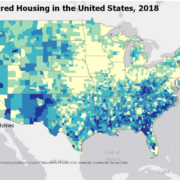HAC News Formats. pdf
February 6, 2013
Vol. 42, No. 3
• February is African American History Month • Series of federal funding decision points looms • Senate committee requests input on its budget resolution • Hurricane Sandy funds approved • HUD offers grants for Native American construction research • Downpayment sources for FHA mortgages addressed • USDA expands Section 502 refinance pilot • RD will continue to accept third-party inspections for 502 direct • Post-closing servicing requirements for MPR properties reiterated • RD addresses servicing for 515 borrowers who received damages • CFPB seeks comments on ability-to-pay rules • CFPB expands HOEPA coverage and housing counseling requirement • CFPB requires copies of appraisals • HUD requests ideas on AHS changes • 44% of U.S. households are “liquid asset poor” • History of rural housing programs summarized in HAC blog post
February 6, 2013
Vol. 42, No. 3
FEBRUARY IS AFRICAN AMERICAN HISTORY MONTH. President Obama’s proclamation is posted online.
SERIES OF FEDERAL FUNDING DECISION POINTS LOOMS. March 1: Automatic, across-the-board spending cuts in discretionary domestic programs (5.1%) and defense will occur unless Congress acts to avert them. March date unknown: The Administration will release its FY14 budget proposal. March 27: The continuing resolution that has provided FY13 funding ends and the government will shut down unless Congress takes action. April 15: Legislators’ salaries will begin to be escrowed as required by the debt ceiling increase bill signed into law by President Obama on February 4, unless/until Congress passes a concurrent budget resolution for FY14. A budget resolution is not binding, so the appropriations committees can begin considering FY14 funding bills without it. May 18/August date unknown: The debt ceiling is suspended through May 18 and then it increases by a formula that is expected to enable the federal government to continue meeting its debts until sometime in August.
SENATE COMMITTEE REQUESTS INPUT ON ITS BUDGET RESOLUTION. Senate Budget Committee chair Patty Murray (D-WA) invites comments and suggestions online.
HURRICANE SANDY FUNDS APPROVED. On January 29 President Obama signed into law a $50.5 billion supplemental appropriations bill that includes $16 billion in disaster CDBG funding for jurisdictions impacted by Hurricane Sandy or any other presidentially declared disaster in 2011, 2012, or 2013.
HUD OFFERS GRANTS FOR NATIVE AMERICAN CONSTRUCTION RESEARCH. Tribes, nonprofits, foundations, and institutions of higher education can apply by March 25 for the Transformation Initiative: Sustainable Construction in Indian Country Small Grant Program. Contact Mike Blanford, HUD, 202-402-5728.
USDA EXPANDS SECTION 502 REFINANCE PILOT. Fifteen states and Puerto Rico are added to the original 19 states (see HAC News, 2/8/12) where Section 502 direct and guaranteed borrowers who are current on payments can refinance to guaranteed loans with lower interest rates. Administrative Notice 4707 is available online or from USDA offices. Contact a USDA office or Kristina Zehr, RD, 309-452-0830, ext. 111.
RD WILL CONTINUE TO ACCEPT THIRD-PARTY INSPECTIONS FOR 502 DIRECT. An Unnumbered Letter dated January 7, 2013 repeats an October 27, 2011 UL.
POST-CLOSING SERVICING REQUIREMENTS FOR MPR PROPERTIES REITERATED. An Unnumbered Letter dated January 22, 2013 repeats a June 21, 2011 UL.
RD ADDRESSES SERVICING FOR 515 BORROWERS WHO RECEIVED DAMAGES. A UL reminds field staff that owners who received damages after settling prepayment litigation are not eligible for incentives or for prepayment.
CFPB SEEKS COMMENTS ON ABILITY-TO-PAY RULES. Comments are due February 25 on Consumer Financial Protection Bureau amendments to its ability-to-pay/qualified mortgage regulation (see HAC News, 1/23/13). Possible changes include exemptions for nonprofits, HFAs, and NFP grantees, and qualified mortgage status for small lenders. HAC will try to make its comments available before the deadline. Contact Jennifer B. Kozma, CFPB, 202-435-7700.
CFPB EXPANDS HOEPA COVERAGE AND HOUSING COUNSELING REQUIREMENT. A final rule expands the types of high cost mortgage loans that are subject to the Home Ownership and Equity Protections Act; imposes new requirements on HOEPA-covered mortgages, including a pre-loan counseling requirement; and exempts reverse mortgages (which were previously exempt), initial construction loans, loans originated and financed by housing finance agencies, and USDA Section 502 direct loans. Contact Richard Arculin, CFPB, 202-435-7700.
CFPB REQUIRES COPIES OF APPRAISALS. Another final rule implements a requirement for lenders to provide applicants with copies of appraisals in connection with applications for first lien mortgages, rather than providing copies only when applicants request them. Contact Owen Bonheimer, CFPB, 202-435-7000.
HUD REQUESTS IDEAS ON AHS CHANGES. HUD seeks input by April 2 on concerns related to redesigning the American Housing Survey sample, content that should be added or dropped, and ideas for data dissemination. Contact Shawn Bucholtz, HUD, 202-402-5538. HAC will try to make its comments available before the deadline.
44% OF U.S. HOUSEHOLDS ARE “LIQUID ASSET POOR” and 26% are “net worth asset poor.” The Corporation for Enterprise Development’s 2013 Assets and Opportunities Scorecard reports that most of these low-asset households have below-poverty level incomes, and a disproportionate number are minorities. Additional data, including state figures, are available online.
HISTORY OF RURAL HOUSING PROGRAMS SUMMARIZED IN HAC BLOG POST. HAC’s latest post on Shelterforce magazine’s Rooflines blog is “So Why Are Those Rural Housing Programs at USDA Anyway?”





